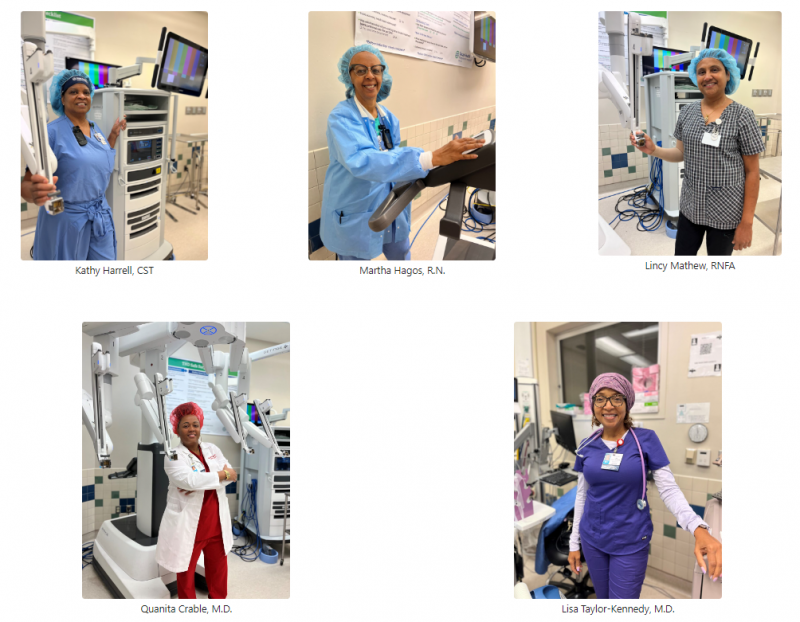Many women prefer seeing a female physician for gynecologic care, but those in Dallas needing specialized care don’t just get a female surgeon.
“The surgical team is a very important, key part of my success in the operating room,” said Quanita Crable, M.D., the first medical director for women’s robotic surgery at Texas Health Presbyterian Hospital Dallas. “We’ve been providing care together for 12 years, and I highlight this because I think to have a successful program, you need a tight-knit team.”
The all-female care team consists of five members: Crable (gynecologic surgeon); Lisa Taylor-Kennedy, M.D. (anesthesiologist); and Lincy Mathew, RNFA (registered nurse first assist), all members of the hospital’s medical staff; and Texas Health Dallas employees Martha Hagos, R.N. (OR nurse), and Kathy Harrell, CST (surgical technologist).
“Being an all-female care team is encouraging for our patients,” said Hagos. “They’re always blown away when they hear we’re all women of color and have been a team for more than a decade.”

The surgical team spends two to three hours in the operating room with each procedure.
Crable is known for performing complex myomectomies, a procedure to remove uterine fibroids while preserving the uterus. She has removed large uterine fibroids using the robotic-assisted da Vinci Surgical System. With the help of this technology, the physician sits at a console next to the patient and operates using tiny instruments. A camera provides a high-definition, 3D-magnified view inside the body.
Harrell says they’ve grown together in the field, adapting as technology and techniques advance, but most importantly, they see each other as family.
“We’re shoulder to shoulder, elbow to elbow in the OR. How can you not consider yourself family?” said Harrell. “The bond we have is really unique, and I think that itself makes patients feel more comfortable.”
The women’s robotic surgery program at Texas Health Dallas offers a variety of procedures, including:
- Hysterectomy: The partial or total surgical removal of the uterus
- Myomectomy: An operation to remove fibroids while preserving the uterus
- Endometriosis resection: Surgery to find and remove endometrial patches on and around the uterus, ovaries, fallopian tubes, bladder, intestines, abdomen and pelvis
- Pelvic organ prolapse: There are two types of surgery for pelvic organ prolapse: obliterative surgery and reconstructive surgery. Obliterative surgery narrows or closes off the vagina to provide support for prolapsed organs. Reconstructive pelvic organ prolapse repair surgery aims to hold the organs in their correct locations.
- Abdominal cerclage: A procedure to close the cervix during a pregnancy that can help prevent miscarriage or premature birth
“Robotic-assisted surgeries are generally considered to provide several benefits over open surgery,” Crable said. “Surgeons can perform procedures in hard-to-reach areas through small incisions, leaving the patient with less scarring. There’s also a lower risk of infection and patients heal much quicker. The quick turnaround typically allows patients to go back to their normal life in two weeks compared to six.”
Texas Health Dallas has more than 20 gynecologic surgeons who have specialized training to perform these types of procedures.
In 2022, just over 500 robotic-assisted surgeries were done in the Margot Perot Center at Texas Health Dallas. So far, a total of 407 procedures have been completed this year.
“This technique has demonstrated it improves outcomes,” said Elizabeth Asturi, M.S.N., R.N., NE-BC, chief nursing officer of Texas Health Dallas. “We’re proud to have highly trained surgeons on the medical staff who offer this safe and less invasive procedure for the women in our community. We are focused on increasing our surgical offerings knowing that the surgical team will help care for women in our community for years to come.”
*Doctors on the medical staffs practice independently and are not employees or agents of Texas Health hospitals or Texas Health Resources.


